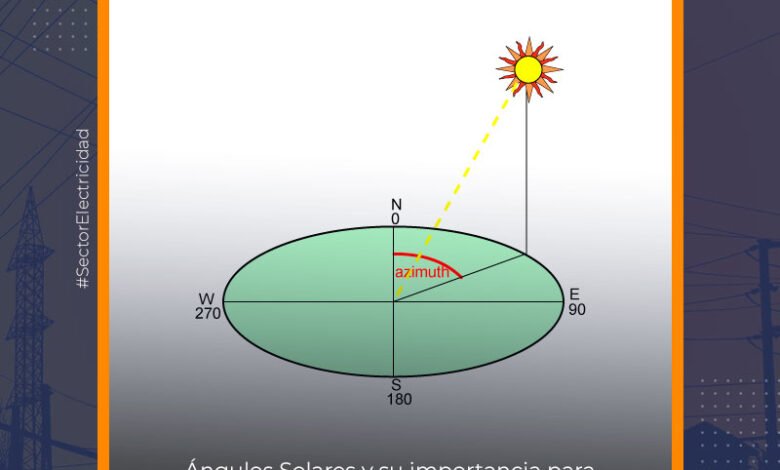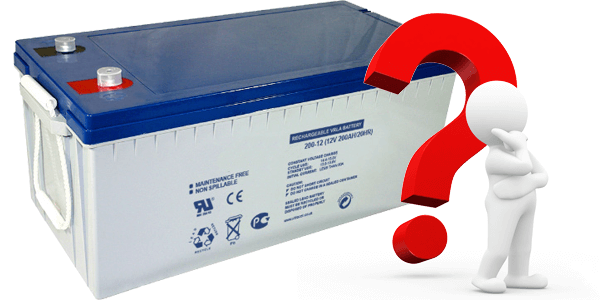
Floating solar power
In this article we will talk about floating solar energy, what you need to know about this practice.
Floating solar power
No one escapes the definitive commitment to solar energy. A reality that takes advantage of the sun’s electromagnetic radiation to generate clean and sustainable energy . It is believed that in less than twenty years almost half of the energy produced in the world will come from renewable energies.
The benefits of this energy are multiple, highlighting among all, the fact that it is a sustainable resource and that it is within the reach of all the countries of the world , to a greater or lesser extent. As if that were not enough, a new scenario is making its way with force. It’s time for floating solar power .
If we take a tour of the countries with the highest installed photovoltaic solar power as of 2020, we see that China is at the top with an installed power of more than 250 gigawatts . Next in the ranking are the United States, Japan, Germany and India with installed photovoltaic solar power between 50 and 95 gigawatts. The bet has no turning back and the figures prove it.
The rise and growth of this trend worldwide is achieving very significant advances in technological terms , reducing the cost of manufacturing panels and improving their performance. In addition, and given the scarcity of land, caused by population growth, the option of making floating solar installations has arisen all over the world , whether on artificial islands , in dams , in swamps, in reservoirs and even in rivers . Technology seems to know no limits when it comes to offering solutions, and floating farms are another proof of that capacity. And it is thatthe future offered by photovoltaic solar energy is unbeatable .
Are these installations profitable ? What advantages do they offer ? If you want an answer to these questions, we invite you to continue reading this article.
Feasibility of floating facilities
Floating installations are in a certain sense easier to carry out than those of terrestrial parks since there is no need to level the surface, since stagnant water, being calm, self-levels , achieving the necessary stillness. The difficulty comes from the need to carry out a cartographic study of the bottom of the reservoir to locate the underwater wiring that will transport the energy generated to the points of consumption: residential or industrial.
The floating farms are made up of several rows of modules anchored to the bottom. The solar panels are installed on highly resistant plastic boards and a flotation system that helps keep the solar panel dry . The panels or rows are joined together forming a large mosaic .
Another characteristic of these farms is that they can be adapted to the necessary size . The only requirement is that the water is calm. And thanks to floating solar installations , lakes from mines and quarries , reservoirs and industrial and agricultural water treatment plants , as well as river plains , can be given extra use .
Benefits of floating solar installations
One of the great advantages of floating solar power plants is the extra use of its location . Another benefit lies in the ease of installation and that the maintenance of these plants is also minimal , being in many cases more accessible to technicians than some of the installations that exist on roofs and roofs of buildings.
Being outdoors and in clear areas, they have no interference or shadows that reduce the performance of the plates. The need for the installation to face south is not a problem either, nor does it require additional studies or projects.
In addition to these aspects, floating farms have a great advantage over land solutions. And it is that in photovoltaic installations, excess heat can reduce the performance of the panels, since the efficiency of the silicon is reduced . The floating panels are lucky in that the water below them will act as a natural coolant and therefore the performance is higher than in an installation with the same characteristics located on land.
In the same way that the water reduces the temperature of the panels, there is a collateral effect that is very attractive for developing countries that see how in the hottest times some of their reserves and aqueducts see their volume reduced due to evaporation. Floating solar energy helps reduce the impact of this evaporation since the panel absorbs part of the sun’s heat and not so much water would evaporate.
The largest floating farms in the world
China is the largest investor in renewable energy in the world , so it is not surprising to guess where the largest floating solar farm in the world is located. In Huainan (Anhui province) on a lake formed in an old coal mine stands the largest facility of its kind on the planet. The plant has a capacity of 40 MW through the more than 165,000 panels that float on the water. This ambitious project, which was installed in 2017, occupies an area of 800,000 square meters or more than 100 hectares and is capable of supplying energy to an entire city.
Japan was the pioneer power in this type of installation in 2007 in Aichi and since then it has built more than 50 floating solar installations of more than 1 MW . In South Korea , work is under way on a 41 MW capacity project on the Hapcheon-gun dam , in the southeast of the country. This floating plant will be the largest in the world and will generate photovoltaic energy to cover the demand of 60,000 people .
In October 2019, the most powerful floating solar power plant in Europe was inaugurated in Piolenc in Vaucluse (France ) . The facility has a capacity of 17 MW and almost 50,000 photovoltaic panels , which are used to supply electricity to almost 10,000 people.
In Spain , the first floating plant was installed in Extremadura in the Sierra Brava reservoir (Cáceres) and has a surface area of 12,000 square meters and 600 photovoltaic modules. There are many projects on irrigation ponds and reservoirs throughout our geography that will see the light of day in the coming months and that certify the success of this type of installation.
At POWEN we offer you the best solar energy solutions for your home . Residential and industrial self-consumption projects tailored to your needs. Let us help you with the photovoltaic installation that most interests you and enjoy the best, cleanest, most economical and sustainable energy.
The 4 advantages of floating solar energy
Floating solar energy is one that uses sheets of stagnant water, such as irrigation ponds, lagoons, lakes, dams, swamps, etc. for the installation of photovoltaic solar energy infrastructures .
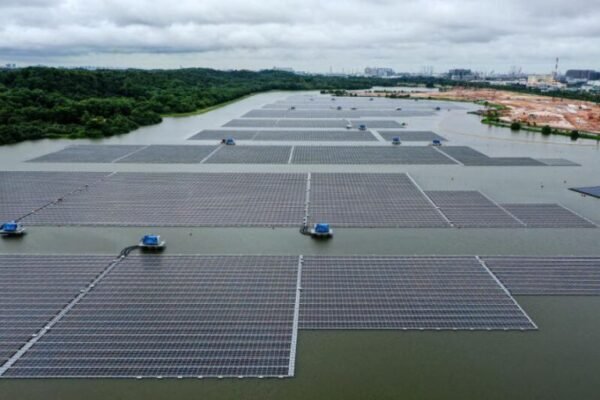
What are floating solar panels ? They are the same photovoltaic modules that are used for installations on the mainland, but they are mounted or installed on platforms or floats that float on the water, interconnected with walkways that form the maintenance corridors.
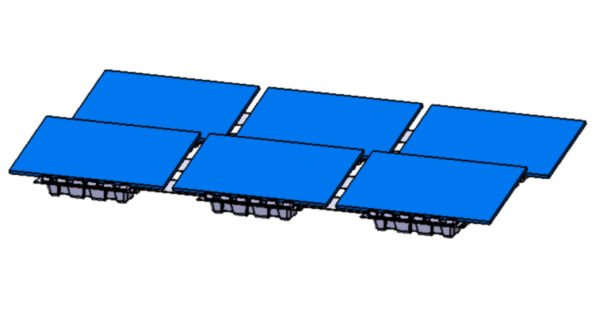
Very popular in Southeast Asia , this type of facility is gradually becoming more popular in Europe with a clear commitment due to its great advantages.
And, what are the advantages of carrying out these installations on water instead of on dry land or on a building?
Keep reading and we will tell you all the advantages of this type of installation.
1. You don’t lose productive land space
Many of the ground-mounted solar photovoltaic installations result in the loss of usable land space for other tasks, such as agriculture. However, by using a floating solar panel system, you don’t require that much occupied land space. These facilities are characterized by being installed in sheets of water that do not interfere with their use, such as water treatment plants, water reserves such as swamps, hydroelectric dams or irrigation ponds.
The result is that you can continue to take advantage of the areas of land that are saved by not having to install your solar plant on dry land. It also preserves the environment and supports deforestation.
2. Benefits for the environment with floating solar energy
Floating solar panels are good for the environment. The water offers a natural cooling system for the solar panels. In addition, they also reduce the evaporation of water from the pond or sheet of water where it has been installed by up to 80%, which is crucial for areas with a high rate of water evaporation (due to temperatures) or in areas where the water it is a scarce commodity.
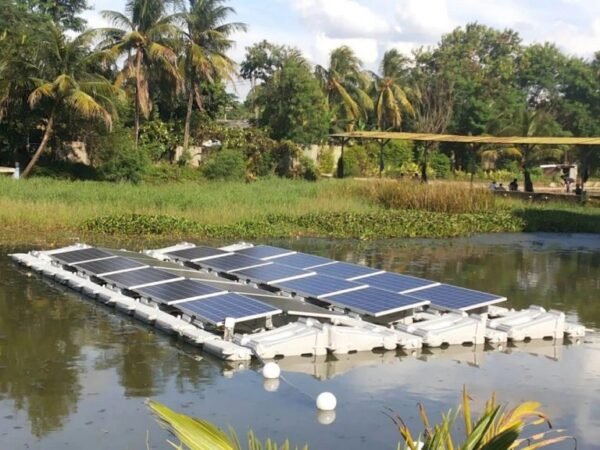
Additionally, having floating solar panels in the water reduces the generation of algae in the pond or water raft where it has been installed, which improves the quality of the water. This is of vital importance in sheets of water intended for human consumption or in irrigated areas where they favor the cleaning of tanks, ditches and pipes.
In addition, the use of clean energy and its generation reduces dependence on energy sources generated with fossil fuels and exhaustible resources, helping to reduce the emission of harmful effect gases.
3. Improvement of the performance of the photovoltaic installation on water
Solar panels work perfectly in high temperature conditions but their efficiency is reduced over time in these types of conditions. As the temperature increases, the efficiency of the panels decreases.
Installing floating solar panels, the very water on which they are installed, produces a cooling effect , by reducing the ambient temperature and increasing the humidity, which improves the efficiency of the panels between 10% and 12%.
4. Simplicity of the infrastructure and assembly
Floating solar panel installations require less material and labor to install compared to a similar installation on land.
The floats on which the plates are installed come pre-assembled and it is only necessary to fix the solar panel on the float, join the floats together and anchor the entire structure with an anchoring system once we have it in the water.
In addition, the entire installation is done on solid ground, on the shore, where operators can work very easily without having to be on structures, roofs or building decks, which facilitates the transport and assembly of the floating solar installation.


